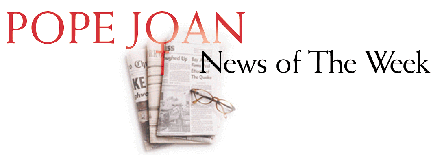Feast of St. Nilus of Sinai
"How many times have I prayed for what seemed a good thing for me . . ."
"Letters ... we get letters ... we get stacks and stacks of letters ... "
(And if you're old enough to know the musical reference, congratulations. You're middle-aged.)
Christopher and I are writing this news together this time. These past few months, we've had an uncommon amount of e-mail to the Pope Joan Workshop Web asking about the history, historical references, and sources for Pope Joan material. Because we're just a teeny-tiny bit tired of repeating the same material to individual writers -- not that we don't love hearing from them, mind you -- we thought we'd set out some basic Joan materials we've used so folks can check out the sources for themselves.
First, forgive a statement of the obvious ... to us. POPE JOAN, the musical, is a dramatic work. It's not a work of history. (It's only a play. It's only a play.) It's a work based on history which uses history as an emotional and ... well, historical ... context. But from the start, when Christopher conceived the play, he wrote an author's note which cautioned the reader that the veracity of our tale was generally considered apocryphal.
Which means there's a lot of truth to it. And a lot of tale-spinning.
What references influenced our telling of the Joan legend?
Well, some European black-and-white lithographs, for one, which depicted a female pope in procession, giving birth. We saw them now and again, used as illustrations in various Joan references.
"The Female Pope" by Rosemary and Darroll Pardoe (Harper-Collins 1988), is an "objective" historical analysis of all aspects of the Pope Joan legend. It's worth noting that these authors could find no primary sources for Joan. They also debunk the fourteenth and fifteenth century references usually cited as "proof" of Joan's existence.
"The Oxford Dictionary of Popes" by J.N.D. Kelly (Oxford 1986) is a classic book detailing the history of the papacy. Pope Joan is referenced in the appendix. It does not include her in the official listing.
"Clothes Make the Man (Female Cross-Dressing in Medieval Europe)" by Valerie Hotchkiss (1996) makes a strong argument for Joan's existence and discusses the prevailing attitudes of the time which would have required her suppression.
The relatively new novel,"Pope Joan" by Donna Woolfolk Cross (Random House 1997) was written after the musical, POPE JOAN. The novelist takes the Joan story in a different direction than we did, postulating that she assumed her brother's identity and dress after he was killed. There is no relationship between the two works, save that they're about the same character.
Bottom line: the historical "truths" didn't matter to us. What intrigued us was the debate. Christopher's imagination began with the classic "what if" and our version of the legend was born.
For the record, King Louis' appearance in the legend of Pope Joan is purely Christopher's invention. It's also Christopher's dramatic construction that he fathers Joan's baby.
But we've already had people speak of the story as we tell it as if it were historical fact. It made sense to them. Therefore, it had to have happened, I guess.
Someday, will POPE JOAN, the musical, appear as an "accurate" source in some yet-to-be-born history student's thesis? Things stay around awhile and they have a tendency to get assimilated into the body of what people -- even scholars -- "know."
The news of the week is written by Production Coordinator Susan Lersch.
Susan may be contacted at susan@orlok.com
| Former News of the Week | Back to "Workshop Elements" | The Production History |

Care to comment or leave a message? Visit the Pope Joan Post Office
Register now for updates and information!
